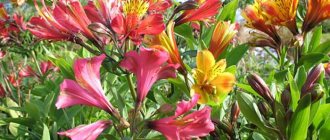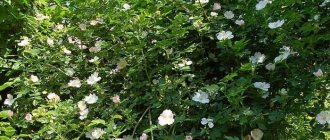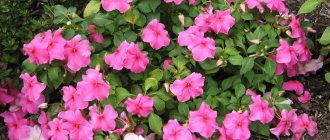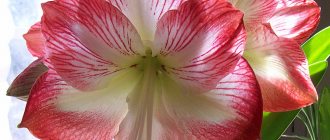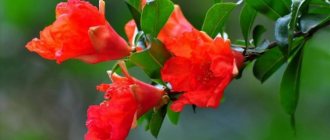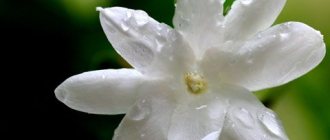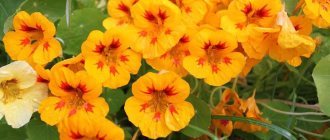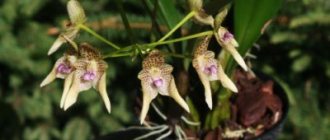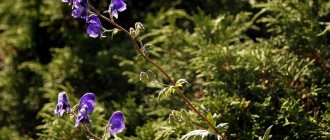Lilies have proven themselves to gardeners as an unpretentious, heat-loving plant that grows well on light soils in the gardens of many regions of the country. One of the Asparagus genera is distinguished by the uniqueness of its flowering - dense dense inflorescences with small buds. We are talking about the pineapple lily, better known in scientific circles as eucomis or eucomis; its long racemose inflorescences are presented in the photo in this issue so that readers can appreciate the plant and its garden species.
Proper propagation will allow you to create an exotic corner in the garden, and proper planting and care will preserve its beauty throughout the summer.
The genus Eukomis (Eukomis) belongs to the Asparagus family, although in other sources it is often classified as Hyacinth plants due to slight similarities. The pineapple lily received its scientific name in 1788 from the French botanist Charles Louis Peritier de Brutel, who considered that the word translated from ancient Greek as “beautiful” was appropriate for this species. Popularly, Eucomis is simply called “pineapple palm” due to the interesting structure of the inflorescences. In the photo below you can see that the top of the brush has a mop of green leaves, which are the bracts of the buds.
The perennial bulbous plant is a herb that can grow from 30 to 100 cm. The genus includes only 14 known species, with only 4 ornamental flowering plants used as a garden crop. A wide distribution in the wild can be seen in the subtropics and tropical forests of South America, some representatives are often found in areas of South Africa. The pineapple lily has a large bulb; on average, its cross-sectional diameter is 5-8 cm, this does not depend on the size of the plant itself. Representatives of Eucomis differ from other genera in their very powerful, rapidly developing root system, which should be taken into account when planting the plant as a container crop at home. From the shiny ovoid bulb, very large ribbon- or belt-shaped leaves are formed, collected in a basal rosette. They have a soft, smooth surface to the touch. Numerous leaf blades with an uneven wavy edge, less often at the base they may have several brown spots. When planting in a pot, you should take into account the impressive size of the leaves - up to 60 cm in length.
At the beginning of summer, a powerful cylindrical peduncle - an arrow - is formed from the middle of the bulb. This is a very elastic stem, reaching a maximum of 1 meter in height. It produces small flowers that look like stars, collected in dense racemose inflorescences up to 30 cm long. The buds can have a white or cream tint with a green, purple or lilac tint. There are species and hybrids that have several shades, for example, Bicolor. The perianths are divided into 6 parts, fused to the base; they do not fall off during flowering. At the top of the inflorescence a “cap” of green bracts is formed; they can often be confused with leaves. They are the ones who make the pineapple lily look like an exotic fruit, as can be seen in the photo below. Most species bloom in the warm season - early June to late July; there are also representatives that can remain decorative until September.
After flowering, a round ovary is formed, consisting of three ribs. Afterwards, you can see the fruits of the “box” with many seeds inside, black or dark brown. The seeds are collected for further propagation; with proper sowing and comfortable conditions, a pineapple lily grown from such planting material will bloom in the 3rd year of life.
Houseplant that looks like a pineapple
Guzmania - an original indoor flower brought from the tropical forests of Central and South America. The genus Guzmania unites about 110 species of perennial herbaceous plants belonging to the bromeliad family. Under natural conditions, most guzmania species grow as epiphytes on trees and branches, but modern hybrids are adapted for growing as potted plants.
This is a plant with a funnel-shaped dense rosette of sword-shaped leaves of light green color. Guzmania is especially decorative during flowering. An inflorescence with bright bracts appears from the center of the rosette. The bracts can be colored in several shades from bright red to orange or yellow. They serve in nature to attract insects. The flowers themselves are inconspicuous. In indoor conditions, guzmania usually blooms in February, March and June, so it goes on sale in large quantities in late autumn.
The most popular varieties of this indoor flower are obtained from guzmania reed (G. linguata) with bright green glossy leaves up to 45 cm long and red bracts with an orange tint.
The mosaic guzmania species (G. musaica) is distinguished by colored leaves with longitudinal and transverse stripes.
The largest species of Guzmania Tsana (G. zanii) - the leaves of this plant can reach 70 cm in length.
Home care for Guzmania:
Lighting and temperature. As a plant from the tropics, guzmania needs to create similar growing conditions. These plants prefer bright places and shade from direct sunlight. Indoor temperature in winter should not fall below +18 0 C.
Air and soil humidity . Guzmania needs warm and humid air and does not tolerate drafts at all. The plant should be sprayed frequently, especially during the growth and flowering period. To maintain humidity, it is better to place the pot on a wide tray with wet pebbles.
Water your guzmania with boiled water at room temperature; rainwater is ideal. When watering, fill the rosette of leaves with water. In hot summers, the plant is watered abundantly, in cool winters, keeping the substrate slightly moist.
In the spring and summer, guzmania is fed with highly diluted fertilizer for decorative flowering plants.
The plant is replanted in spring or summer by transferring it into a slightly larger pot. The land is made up of turf, leaf and peat. Reproduction. If the guzmania has side shoots during transplantation, they can be separated from the mother plant and planted in another pot.
Experienced gardeners can try growing guzmania from seeds. They are sown in a small container without covering them with soil, placed in a bright place and constantly maintained at high humidity and a temperature not lower than 22 0 C. When shoots appear, the plant will bloom only after three years.
The most dangerous for guzmania are fungal diseases that cause rotting of leaves at the base of the rosette or roots, which can be determined by the browning of the leaves. The cause may be excessive watering. You should reduce watering, pour water only into the rosette of leaves and treat with fungicides.
Exotic "relatives"
African chamomile or osteospermum is a rare flower in our country. Another known name is Cape daisy. The petals are not only white, but also blue, purple, lilac, red, yellow, and orange. The basket dimensions are 3–8 cm. Interesting hybrids with unusual petal shapes, for example, resembling a spoon (spoon osteospermum), have been bred. Most similar to chamomile:
16 excellent varieties of plums for the Moscow region
- Barberiae;
- Eklona;
- The osteospermum is noticeable.
The bushes bloom profusely and branch. The plant does not lose its attractiveness even in rainy weather. To make friends with African chamomile, it is enough to prepare a sunny area with well-drained, not too fertile soil. The plant is thermophilic; at -10 °C in open ground it will die. For the winter they are transplanted and kept in cool rooms (+5...+10 °C).
Gazania (gatsaniya) is another African “guest”. A low-growing plant (30 cm) with petals of red, orange, pink or yellow. The leaves are textured, dark green or with a grayish coating. Grown as an annual and perennial. With the right agricultural technology and in favorable conditions, gatsaniya blooms all summer. The plant practically does not get sick, but can be affected by insects: mites and aphids. For the winter, the bushes are dug up and kept in a well-lit, cool place. Rarely watered.
Ursinia is native to South Africa. Of the cultivated species, not all are suitable for the climate of the Middle Zone; Ursinia dill is most adapted to it. The plant is not left to overwinter; it is grown as an annual. Popular varieties:
For abundant flowering, Ursinia requires 5 hours of sunlight.
Indoor pineapple: photo and care
Of course, you won’t have to enjoy indoor pineapple (Ananas), because it is an ornamental plant, but you will definitely be able to surprise your neighbors by having such a miracle on your windowsill. With proper care for an indoor pineapple, you can get a fairly large fruit, barely distinguishable from a real fruit.
You will learn below how to care for an indoor pineapple and how to propagate this home plant.
Family: Bromeliads, light-loving, moisture-loving.
The crested pineapple (Ananas comosus) is usually grown indoors - a large terrestrial plant with a greatly shortened stem and a rosette of rigid linear sword-shaped leaves (can reach 2 m in diameter and 1 m in height).
The leaves of the indoor pineapple plant are gray-green, grooved, very narrowed towards the apex, completely covered with scales, and lined with sharp spines along the edges.
Flowers with pinkish-purple petals are arranged in a spiral in dense spike-shaped inflorescences and covered with wide cup-shaped bracts.
As you can see in the photo of an indoor pineapple, after flowering ends, a compact golden-yellow fruit, similar to a cone, is formed.
There is also a variegated variety - "Variegatus" with green-cream longitudinal stripes on the leaves that turn pink in bright light.
The bracted pineapple (Ananas bracteatus) looks even more elegant with bright striped green-cream-pink leaves.
Pineapple has powerful positive energy. This is a plant of renewal, spiritual awakening. The presence of pineapple in the house will make life varied and colorful, emotionally rich, and festive.
Caring for a houseplant pineapple at home
Pineapple can be grown on southern and southwestern windows at temperatures not lower than +18 °C in winter. When caring for indoor pineapple, the plant in spring and summer during the period of active growth is watered generously, sprayed and fed once every two weeks. In autumn and winter, watering is reduced, but the earthen ball is not allowed to dry out. Pineapple is transplanted annually in the spring by transferring it into a larger container. A soil mixture consisting of leaf soil, turf soil, and sand (2:1:1) is well suited for planting.
Propagation of indoor pineapple
Indoor pineapple is propagated by seeds or by rooting the apical shoot. To do this, the “sultan” of the ripe fruit is cut off, capturing the “heel” (a piece of pulp 0.5-1 cm thick), dried for 2-3 days and planted in sphagnum with a slight depth. For the formation of roots, warmth, regular moderate moisture and time (3-4 weeks) are necessary, after which the seedling can be transplanted into the soil mixture described above. Reproduction is also possible by separating offspring that form at the base of an adult plant.
Fruit
How do pineapples (fruits) grow? After the end of the flowering period, a very powerful infructescence is formed on the bush of the plant. From it the fruit develops in the future. Moreover, at the top of each fruit a tuft or palm appears, in the same shape as the bush itself, but smaller in size. To grow a new fruit, this top is cut off and planted. However, pineapples are not always self-pollinating. There are subspecies that have only male or only female flowers. In this case, the plant is pollinated by bees and other insects, and seeds are formed in the fruits.
Wild fruits are usually small in size, and almost all of them have many seeds, which various animals like to feast on.
After the first fruit ripens, the lateral shoots that form from the axils of the leaves begin to grow intensively. These shoots are subsequently used to propagate pineapples in cultivated form. When the side shoots are removed, the mother plant blooms again after some time and produces fruit again. The plants are completely torn out after the second harvest, and new ones are planted in their place.
An indoor flower that looks like a pineapple. Houseplant pineapple, care at home, photo
Popular materials
Today's:
- Escape in the form of a diagram. Laboratory work . Getting to know the external structure of a plant
- Swallow the garlic without chewing. Why swallow a clove of garlic on an empty stomach?
- Thuja in a pot in winter on the street forum. Preparing thuja for winter - shelter and proper care
- Houseplant ID. How to find out the name of an indoor flower using a identifier and the Internet
- The name of indoor plants and their homeland. Houseplants: homeland, types, care
- Sticky drops on the back of hibiscus leaves. Sticky hibiscus leaves
- Bird droppings, how to apply in the fall. Chicken manure as fertilizer: recommendations for application
- An indoor flower that looks like a pineapple. Houseplant pineapple, care at home, photo
- Description and types
- Reproduction
- Houseplant pineapple: care
- Large tufted pineapple calories. Pineapple - protector of the heart
- It's a pineapple. General information
- What are the benefits of the fruit?
An indoor flower that looks like a pineapple. Houseplant pineapple, care at home, photo
Many people love juicy and aromatic pineapples, but not everyone knows that the pineapple plant has a very close relative.
A houseplant that looks like a pineapple, just like everyone’s favorite fruit, comes from South America. This herbaceous specimen of the Bromeliad family is called tricolor pineapple bract. This type of tropical grass is the most decorative, thanks to its amazing colors and unusual appearance, and it is also very popular among lovers of exotic floriculture.
Description and types
The plant has long, sharp, dark green leaves with wide longitudinal stripes of cream or pink and thorns along the edges that form a rosette. The leaves reach a length of 70 cm. Its inflorescence is similar to the inflorescence of a regular pineapple, only different in color. If the plant is exposed to bright sunlight, the leaves and inflorescence take on a red tint. Pineapple, a houseplant, does not bear fruit at home.
Of the many species of this exotic guest, the most popular is the large-tufted pineapple. This is a beautiful individual with a short, powerful stem and inflorescence, from which fleshy, thick, leathery leaves emerge, forming a kind of tuft. Its fruits are inedible.
These plants are quite large in size, so growing them requires a spacious room.
Reproduction
The plant, similar to a pineapple, reproduces by layering, which is taken from an adult, or by apical rosettes. Indoor species do not produce seeds.
- The apical rosette is cut off with a sharp knife with part of the pulp, the cut is treated with activated carbon, and the planting material is kept in the open air for 5 days. Then it is placed in a container with specially prepared soil for rooting, which is then covered with film.
- Propagation by layering is easier than by rosettes, since the former already have roots. They are taken when the length reaches 15-20 cm and placed in a pot with soil for better rooting.
Houseplant pineapple: care
An exotic guest requires increased attention:
- he loves bright light and direct sunlight. The southern window sill will be the most optimal location option;
- the air temperature in summer should be between +22 -+28 degrees, and in winter - +18 -+20;
- Watering during the growing season is necessary abundantly as the soil in the pot dries out, and during the dormant period their amount is reduced. Water the individual with settled soft water heated to a temperature of +35 degrees;
- in hot weather it is necessary to ensure high air humidity, so the flower pot is placed on a tray with wet gravel;
- During the growth period, the plant requires periodic feeding, which should be done once every two weeks with liquid complex fertilizer for indoor plants. During the rest period, these procedures are stopped;
- Once every two years the flower needs to be replanted into a larger container.
Large tufted pineapple calories. Pineapple - protector of the heart
Pineapples are native to South America and were brought to Europe by Christopher Columbus. One of the species, Pineapple large-tufted, is considered an important fruit crop, widely grown in tropical countries.
The calorie content of pineapple is very low and amounts to only 49 kcal per 100 grams of product. Pineapple contains a lot of dietary fiber and organic acids; it is rich in magnesium, manganese, iodine, potassium, calcium, phosphorus, and iron. In addition, pineapple contains important vitamins B1, B2, B12, PP and A. All this makes it a valuable source of nutrients for the human body.
The beneficial properties of pineapple are that it lowers blood pressure, thins the blood and fights the development of many dangerous diseases of the cardiovascular system, such as atherosclerosis, vascular thrombosis, stroke and even myocardial infarction. Pineapple also helps remove excess fluid from the body.
The benefit of pineapple also lies in the fact that pineapple improves digestion by increasing the enzymatic activity of gastric juice; therefore, if you eat plenty of food, it is strongly recommended to add it to your diet.
It is extremely interesting that fresh pineapple fruit contains the digestive enzyme bromelain, which promotes the breakdown of proteins. Bromelain can destroy blood clots in blood vessels and, as a result, will be useful in the treatment and prevention of cardiovascular diseases. It is also not unreasonable to believe that it can be used to fight urinary tract infections. Bromelain is especially good at helping the body absorb fish, meat, dairy products and legumes.
When choosing a pineapple, pay attention to the leaves at the top of the fruit - if some of them are easily pulled out, the fruit is ripe enough.
It's a pineapple. General information
Is pineapple a fruit or a vegetable, a berry or a fruit?
This plant is a grass. Some breeders claim that it is a fruit, but they agree that the compound fruit is not a berry, vegetable or grain.
When mature, the pineapple has a short, mundane stem with tough, toothed leaves that reach 80 centimeters in length and 150 centimeters in height.
The fruit of a tropical perennial is golden yellow. Depending on the variety, it weighs 2–15 kilograms and reaches 10–30 centimeters in height. Visually, the inflorescence resembles an oblong cone and consists of many ovaries. The top of the fruit is decorated with a green top.
The exotic fruit tastes sweet and sour, which is why it is used in cooking: it is the basis for making salads, pizza, desserts, sweets and jam.
What are the benefits of the fruit?
Pineapple contains a unique enzyme complex - bromelain, which accelerates the breakdown of fats and proteins. In addition, the pulp of the exotic fruit is a storehouse of vitamins, minerals, beneficial aromatic substances and organic acids.
The fruit has an anti-edematous effect and has an antibacterial effect. It reduces blood viscosity, prevents the formation of thrombophlebitis and thrombosis, eliminates deposits on the walls of blood vessels, and reduces pain in muscles and joints.
Pineapple plantations are concentrated in countries with subtropical and tropical climates. World leaders in growing herbaceous plants: Brazil (12.3%), Thailand (11.4%), Philippines (10.9%).
Features of growth
Pineapple is a perennial plant. In the first months after planting, it actively increases its green mass, forming a large “rosette” of leaves. Its trunk grows tall and thickens, and its leaves thicken. Despite the apparent toughness, the leaves of the plant are very juicy inside. This is due to the fact that in the places where the plant grows there is often a lack of moisture. This explains the peculiarity of the structure of the leaf plates - they look like grooves along which rainwater flows to the stem and roots of the bush. The leaves retain moisture to nourish the plant and help it survive dry periods.
Under what conditions does it grow?
Growing exotic fruits is possible only in the tropics, since pineapples grow in a climate with a constant temperature of 25 degrees. It can survive without water for a long time, but without heat and sunlight it will quickly wither and die. Therefore, growing pineapple requires a special climate.
If cultivation is carried out in greenhouse conditions, it is extremely important to ensure constant high temperature and diffused light in the greenhouse
In which countries does it grow?
Pineapple grows in the tropics, and can be found in all tropical countries of the globe. In terms of scale of cultivation, pineapple ranks third among all tropical fruits. No country with suitable climatic conditions would want to miss the opportunity to make money from growing such a sought-after product. The largest producers of pineapples are Brazil, Thailand, Taiwan, the Philippines, India, and Costa Rica.
How to grow pineapple at home
Name: Pineapple (Ananas)
Family: Bromeliads (Fam. Bromeliaceae)
Pineapple is an unusual and beautiful indoor plant; especially variegated varieties look bright and cheerful. The pineapple forms an inflorescence, which consists of dozens of flowers, and if you want the fruit to appear, they must be left on the plant.
It is worth noting that pineapples bloom infrequently at home. At home, the height can reach 70 cm with good care.
This terrestrial bromeliad is known for its fruit. Pineapple originates from Brazil, but due to high commercial demand, it has spread to other regions of the planet.
plant pineapple at home
Location
This plant needs a lot of light, and even direct sunlight is favorable for varieties and species with marbled leaves. The ideal temperature ranges between 18 and 22°C. In the autumn-winter period there may not be enough light and the pineapple flower with fluorescent lamps for 8-10 hours a day.
Watering
Requires moderate watering and high humidity. Some experts recommend watering with water heated to 30-35°C. Make sure the soil is dry before watering again; try to keep the water free of lime. In summer, pour moisture into the funnel formed by the leaves. To keep the plant clean, it is enough to spray the leaves from time to time. In summer you need to spray pineapple 2 times a week, in winter 1 time a week.
The soil
When replanting plants, use small pots. Pineapples have a shallow root system and a low, wide pot will do. Use a porous substrate that can easily drain water, such as a mixture of peat, humus and sand. In summer, fertilize with liquid fertilizer, dissolving it in water. Carry out preventive pruning: remove yellow and dry leaves.
Bloom
Pineapple blooms in March-July, but it also happens in December. Plants usually bloom when they are 3-4 years old. The fruit looks like a cone. The fruit ripens in 4-5 months. Pineapples can bloom faster if you place ripe apples in a bag draped over the plant. Apples produce ethylene, which promotes the appearance of flowers.
pineapple comosus champaka
Plant pineapple at home
To obtain new specimens, use the shoots that appear at the base of the mother plant, since the green parts of the individual die off after fruiting. In order for them to grow faster, they must be kept warm at a temperature of 24”C.
Another possibility for obtaining a new plant is to cut the top leaves from a mature fruit, but if it has a full rosette of leaves, and root them. Cut off the top of the fruit (sultan), lightly dry the pulp for 2-3 days, separate the pulp and plant in peat with sand, maintaining a temperature of 24°C. Roots appear in 2-4 weeks, with constant moisture. It is recommended to cover the sultan with a jar or plastic bag.
Quick rooting of pineapple
Quick Rooting of Pineapple - Place the top in a vase and within a few weeks the pineapple will be ready to plant.
Transfer
The plant is replanted twice, 3 months after the separation of the lateral shoot and a year later. The pot should be a little small and have good drainage. Do not compact the soil too much.
indoor flower pineapple
Trimming
No need other than removing damaged and dry leaves.
Pests and diseases
This species is sensitive to damage by scale insects. If yellow spots appear on the leaves, check the stem and undersides of the leaves. Remove the scale insects using a cotton swab soaked in alcohol.
Pineapple types and varieties
The most common variety in indoor floriculture is the variety obtained from the American pineapple - Ananas comosus variegatus with very picturesque foliage. An elegant inflorescence with dense blue flowers forms a red fruit, similar to a pineapple, but, unlike the latter, it is inedible.
Ananas bracteatus striatus is large in size and has reddish fruits of a very pleasant shade.
ananas bracteatus striatus
ananas bracteatus striatus
pineapple comosus ivory coast
pineapple comosus macgregor
Problems in caring for pineapple
Weakened leaves that have lost their elasticity with dry tips: dry indoors. To increase air humidity, regularly spray the leaves with water.
Discolored leaves: insufficient light. Place the plant in a brighter area.
Root rot: excess moisture; cold indoors. Place the plant in a warm place and let the soil dry.
The tips of the leaves dry out: dry air.
Mold on the soil or on the walls of the pot: excessive watering in winter, remove mold from the surface of the pot with a cloth, reduce watering.
Small light spots on the leaves: most likely a false scale insect, it is necessary to spray the plant with a weak solution of potassium permanganate.
Growth slows down: very low soil and air temperatures.
This is interesting
When handling the plant, be careful - try to avoid contact with the sharp teeth of the leaves. In bromeliads, the rosette dies after flowering and fruiting. The plant produces two or three lateral offspring. About 2 years pass from the appearance of the shoot to the death of the rosette.
Large-tufted pineapple – prevents complications of kidney and gallbladder diseases.
Similar plants:
- Aechmea flower striped
- Room Guzmania
Growing gerberas
Nowadays gerberas are grown mainly as hybrids. They are successfully cultivated in almost any climatic zone. Due to the spectacular shape of the flowers, this plant is often used in bouquets. Cut gerberas can be stored in water for up to 20 days. To ensure they last a long time, it is recommended to pour only a small amount of water into the vase so that the stem does not have time to rot.
More than 1000 varieties of gerberas are known, each of which differs in the shape of the inflorescence and the color of the petals. There are varieties with pink, white, orange, red, yellow, and black flower colors. Breeders have not yet managed to achieve only one color of gerbera petals - blue. Some gerberas may have petals of different colors on one flower.
Gerbera prefers to grow in a sunny place. It needs to be watered so that water does not get into the rosette of leaves - otherwise the plant will rot and die.
While tall gerberas are good in a flower bed, they prefer to grow dwarf varieties of this plant indoors. For a gerbera to bloom, it needs short daylight hours and good ventilation.
Acanthostachys
Acanthostachys is a fairly popular plant, which, indeed, is the closest relative of the pineapple, since together with it it belongs to the same bromeliad family.
The distribution range of representatives of this family is the tropics and subtropics of America and western Africa. But in the wild it is found mainly only in Argentina and Brazil.
Acanthostachys is a herbaceous perennial epiphytic plant that can grow not only in the soil, but also on tree trunks. Its name consists of two Greek words, translated meaning “thorn” and “ear”. Large beautiful flowers, characteristic of most bromeliads, look like spikes, and thorns - small sharp spines - are located along the edges of narrow and long, drooping leaves, collected in a spreading basal rosette. The leaves are dark green, sometimes slightly silvery, can reach one meter in length and no more than 1 cm in width. The height of the plant itself is 30–50 cm.
Acanthostachis blooms for quite a long time - from July to September. The flowers are unscented and grow from the middle of the rosette, but what is usually mistaken for a single large flower is actually an inflorescence. The fruits are also fused and form a large fruit cluster, similar to a pineapple.
Common types of acanthostachis
It is generally accepted to classify a plant as a monotypic genus, that is, consisting of plants of only one species. This is acanthostachis cone-shaped - with bright orange flowers and a cone-shaped fruit. It is this species that is mainly widespread in indoor floriculture.
However, in some sources you can find a description of a plant called - acanthostachis pitcairnioides , the synonym of which is Aechmea pitcairnioides. Aechmea, as you know, is another genus of the bromeliad family, but in appearance the described plant is, indeed, more similar to a typical acanthostachys.
U a. Pitcairnioides is brighter - rich dark green in color with a pink border along the edges and larger spines. And the inflorescences are of an unusual, very delicate, light blue color.
Care and cultivation of acanthostachis
Acanthostachis, like all epiphytes, has a poorly developed root system, which allows it to be grown not only in small pots, but also in small baskets on pieces of wood. Both ordinary potted and hanging plants. It grows quickly, is considered unpretentious and easy to care for, but still has its own preferences that must be adhered to.
You can prepare the soil for growing acanthostachis yourself. It is advisable to add one part of tree bark and any drainage material - sand, expanded clay or small pebbles - to the soil mixture consisting of leaf soil and humus (proportion 4:2). When using pieces of wood as a container, the plant is first carefully removed from the pot and its roots and soil are wrapped in damp sphagnum, and then secured to a support.
It is undemanding to lighting and can grow in the shade and at a considerable distance from the light source. Direct sunlight causes burns on the leaves, so the light should be dim and diffused, such as, for example, on the windowsills of north-facing windows. The room temperature should be moderate. In summer, the optimal temperature range is 20–25 degrees Celsius; in winter, the temperature is reduced by 7–8 degrees lower.
The dormant period in the life of acanthostachis begins after flowering and seed ripening and continues until spring. At this time, fertilizing is usually not carried out, and the frequency of watering is halved. During the active growing season, do not water too much. The soil on the surface should dry out slightly. Constant waterlogging can lead to rotting of the roots, but overdrying is also detrimental.
It is more sensitive to air humidity, so when grown in non-greenhouse conditions it requires frequent spraying. Water, just like when watering, should be used at room temperature. Cold and hard can lead to root disease and leaf drying.
It is recommended to feed Akntostachis from May to September, once every two weeks. It is better to use liquid fertilizers - universal mineral fertilizers or those specifically designed for Bromeliads.
It is advisable to replant annually, in early spring. At the same time, the size of the container is not greatly increased, because it usually begins to bloom only in conditions when the entire earthen ball is closely intertwined with roots.
Reproduction of acanthostachis
Reproduction is possible both by seed and vegetative methods. At the base of the maternal rosette of Acanthostachis pineal, young lateral shoots are usually formed. They are carefully separated with a sharp knife, the sections are sprinkled with crushed charcoal and dried for 8–12 hours. Then the children are planted in a soil mixture made up of peat, leaf humus and sand (1:1:1). Rooting occurs better at high humidity, which can be maintained by regular spraying, and at a temperature of about +20 degrees.
To germinate seeds, more comfortable conditions are needed. Before sowing, they are soaked for several hours in a weak solution of potassium permanganate, then slightly dried. Sow in a substrate consisting of crushed sphagnum and cover with glass. The temperature in the mini-greenhouse should be within 20-22 degrees Celsius. Regular spraying of the substrate and ventilation are also necessary. The emerging seedlings are gradually hardened by opening the glass slightly, and planted in the phase of appearance of 2-3 leaves.
Quartblog Digest
Buying indoor plants: step-by-step instructions. — We buy indoor plants that will grow and delight us for many years. The quartblog will tell you how to make the right choice!
Climbing indoor plants: everything you need to know about care - In this article we will talk about climbing indoor plants, their types and names, show photos and give some useful tips for care
Plants for interior decoration - What plants will decorate the interior and require a minimum of care? We have prepared some simple tips for choosing and placing indoor plants in the interior.
When and how to fertilize plants? Part 1 - When to feed plants, what feedings and at what time will bring the greatest benefit to indoor and garden plants.
How to repot indoor plants - repotting indoor plants. We'll tell you and show you how to do it correctly and usefully for our green friends!
houseplants
Doronicum
Doronicum is distinguished by the fact that even after cutting it retains its beautiful and bright appearance. Therefore, it is often dried and placed in a vase or painting as a decoration. It grows massively in the mountains, mainly in the Alps, from where it has spread throughout the world. There are several types of it, from the smallest, whose height starts from ten centimeters, to tall and stately ones, about eighty centimeters high. Depending on the species, it can bloom either at the beginning or at the end of summer. The yellow core is framed by bright yellow petals, the leaves have an elongated triangular shape and a strong stem has a rich green color. In some species, the leaves have a light fluff. Thanks to such a bright color of the petals, it is called “sunny daisy”. It is a perennial plant and can grow in one place for more than ten years, but during this time it grows so strongly and densely that it begins to suffer from powdery mildew.
rainbow flower
The rhizomatous perennial belongs to the Kasatiaceae family and has almost 800 species, distributed almost throughout the planet. It is difficult to find a person who does not know what an iris looks like - its flower is so unusual that once you see it, you will not forget it. But if there are any, we offer a description of the plant.
Its rhizome is creeping, divided into annual units. A fan of flat sword-shaped leaves sprouts from each segment in the spring. From this bunch comes a thick, durable peduncle, on which 1 to 6 single flowers bloom.
The flower itself is large - 7.5–11 cm high, up to 18 cm in diameter, consists of 6 petals (lobes) - three internal and three external. The inner petals are usually raised upward and form a “crown” or “glass”. The outer lobes, also called fouls, diverge horizontally to the sides or are lowered down.
Both the variegated colors of the petals and the palette of numerous varieties of irises confirm the name of the flower, which is translated from Greek as “rainbow”. There are a variety of tones and combinations:
- plain (self) – white, pastel, rich, almost black;
- combinations with traditional color combinations - white and blue, yellow and brown;
- contrasting combinations of tones and shades, for example, pink and lavender;
- variegated (speckled, edged).
There is no single international classification of the plant - in our country only rhizomatous perennials are called irises; in Europe, bulbous relatives of the flower are also included in the same genus. And the domestic garden classification does not add clarity to the simple amateur gardener. Without going into botanical details, the following types of irises are most often grown in gardens and parks:
- bearded (the most numerous, widespread and sought-after group);
- Siberian;
- Japanese;
- Spuria irises;
- bulbous hybrids (Dutch or English).
Before purchasing collectible irises, carefully read the assortment and resistance of the specimen you like to the climatic conditions of your region. Many of the hybrids bred in the USA, Japan, Holland, Australia are heat-loving and cannot withstand the frosts of the middle zone, not to mention Siberia or the Urals.
Description of the family
An exotic flower with pineapple-like leaves or flowers native to the tropics of America. The family includes several thousand plants with different characteristics. In apartment conditions, compact varieties are mainly grown; their leaves are often rosette-shaped.
Most bromeliads form a rosette of leaves that resembles a vase. In nature, it collects water that the plant feeds on.
In the photos of plants you can see the general characteristics of bromeliad varieties: they have hard, lily-like, belt-shaped leaves. They can be plain or have a spotted and striped pattern.
Bromeliad indoor plants are considered flowering plants, but in fact they are brightly colored inflorescences, and their flowers are small and ugly.
Interesting! Some varieties of bromeliads during flowering can change the color of the leaves in the funnel, so the plant looks like one large flower .
In the natural environment, the flowering of bromeliads coincides with our winter, the dormant period of most plants. The duration of flowering is several months, after which the plant dies and babies form on the side. Young rosettes grow for 3 years, after which they bloom and also leave successors to the family. Developing side rosettes is a method of propagating plants at home.
Despite the fact that the roots of tropical plants are poorly developed, the leaf rosette is able to fully nourish the plant, due to the presence of cells and scales on its surface.
Interesting! Due to the ability of the rosette to retain moisture and nourish the plant, the presence of foliar fertilizers is important for bromeliads. In summer and spring, spraying with a solution of a low concentration of the mineral complex is necessary, twice a month.
Salal
Salal is the name of a very beautiful decorative greenery that perfectly complements color compositions. Salal is very versatile and practical.
Many flowers, such as roses, look exceptionally impressive when framed in salal. Strong and dense salal leaves serve not only as a harmonious frame, giving a bouquet of flowers splendor, but also very well support the buds of the main flowers in the composition. Flower bouquets in which a salal pillow is used instead of packaging look very original, luxurious and stylish. In floral arrangements, salal performs the functions of supporting a bouquet not only in fresh, but also in dried form.
Since salal goes well with almost all flowering plants, florists create a variety of compositions with its participation, from modest and delicate to incredible and creative. If the bouquet consists of flowers of the same shade, the use of salal is optimal to visually “separate” the flowers from each other.
Another important quality of this decorative greenery, beloved by florists, is its vitality, thanks to which floral works with salal remain fresh and colorful for a long time.
Growing in greenhouses
Pineapple is a heat-loving plant. Although it can remain without water for quite a long time, it will not be able to grow without sunlight. Therefore, it is necessary that the greenhouse premises be warm and with diffused light. This method of growing pineapples is widely used in European countries and southern Russia. The growing technology here is slightly different.
Instead of natural soil, a soil mixture is used, irrigated with slightly acidified water. This leads to rapid growth of the plant. There is a special condition here. Watering should not be done with cold water. It must be at ambient temperature. Under no circumstances should the plant be flooded and the water allowed to stagnate.
